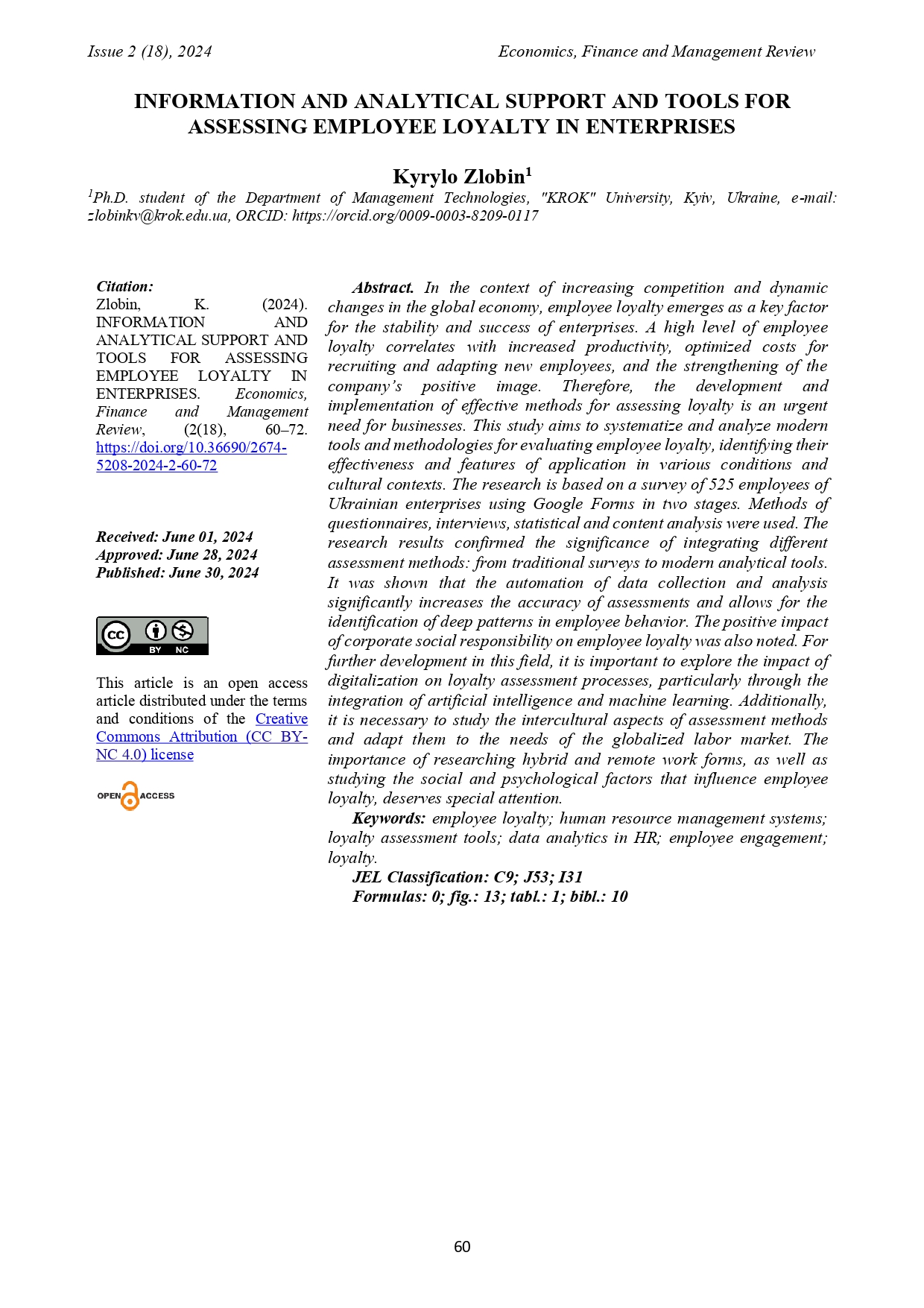INFORMATION AND ANALYTICAL SUPPORT AND TOOLS FOR ASSESSING EMPLOYEE LOYALTY IN ENTERPRISES
DOI:
https://doi.org/10.36690/2674-5208-2024-2-60-72Keywords:
employee loyalty, human resource management systems, loyalty assessment tools, data analytics in HR, employee engagement, loyaltyAbstract
In the context of increasing competition and dynamic changes in the global economy, employee loyalty emerges as a key factor for the stability and success of enterprises. A high level of employee loyalty correlates with increased productivity, optimized costs for recruiting and adapting new employees, and the strengthening of the company’s positive image. Therefore, the development and implementation of effective methods for assessing loyalty is an urgent need for businesses. This study aims to systematize and analyze modern tools and methodologies for evaluating employee loyalty, identifying their effectiveness and features of application in various conditions and cultural contexts. The research is based on a survey of 525 employees of Ukrainian enterprises using Google Forms in two stages. Methods of questionnaires, interviews, statistical and content analysis were used. The research results confirmed the significance of integrating different assessment methods: from traditional surveys to modern analytical tools. It was shown that the automation of data collection and analysis significantly increases the accuracy of assessments and allows for the identification of deep patterns in employee behavior. The positive impact of corporate social responsibility on employee loyalty was also noted. For further development in this field, it is important to explore the impact of digitalization on loyalty assessment processes, particularly through the integration of artificial intelligence and machine learning. Additionally, it is necessary to study the intercultural aspects of assessment methods and adapt them to the needs of the globalized labor market. The importance of researching hybrid and remote work forms, as well as studying the social and psychological factors that influence employee loyalty, deserves special attention.
Downloads
References
Hair, J. F., Black, W. C., Babin, B. J., & Anderson, R. E. (2010). Multivariate data analysis (7th ed.). Pearson.
Hancock, J. I., Allen, D. G., Bosco, F. A., McDaniel, K. R., & Pierce, C. A. (2013). Meta-analytic review of employee turnover as a predictor of firm performance. Journal of Management, 39(3), 573-603.
Kirkman, B. L., & Rosen, B. (1999). Beyond self-management: Antecedents and consequences of team empowerment. Academy of Management Journal, 42(1), 58-74.
Krippendorff, K. (2018). Content analysis: An introduction to its methodology. Sage publications.
Mihus I. P. (2012). Personnel security of subjects of economic activity: management by insiders: monograph / by general. ed. Prof. Migus I.P. Cherkasy: "MAKLAUT". 315 p.
Mihus, I. (2018). CREATING A SYSTEM OF STAFF SECURITY MANAGEMENT AT THE ENTERPRISE. Science Notes of KROK University, (4 (52), 213–221. https://doi.org/10.31732/2663-2209-2018-52-213-221
Mihus, I. P. (2018). Creation of a personnel safety management system at the enterprise. Scientific notes of the University "KROK", (4 (52), 213–221. https://doi.org/10.31732/2663-2209-2018-52-213-221
Mihus, I. P., & Chernenko, S. A. (2013). Evaluation of personnel loyalty in the context of ensuring the economic security of the enterprise. Agrosvit, (11), 24-27.
Smith, A., & Macko, M. (2014). Employee satisfaction, loyalty and financial performance: The impact of leadership. Journal of Leadership Studies, 8(3), 16-27.
Stone, D. L., & Deadrick, D. L. (2015). Challenges and opportunities affecting the future of human resource management. Human Resource Management Review, 25(2), 139-145.

Downloads
Published
How to Cite
Issue
Section
License

This work is licensed under a Creative Commons Attribution-NonCommercial 4.0 International License.








